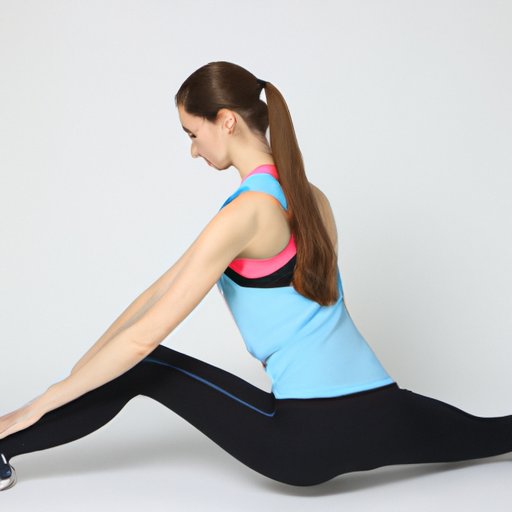
I. Introduction
Bad posture is a common problem that affects many people today. It is characterized by the incorrect alignment of the spine, leading to a range of negative physical and mental outcomes. Poor posture can lead to chronic pain, decreased mobility, and even psychological distress.
But there’s good news. With some effort and consistency, you can correct your bad posture and enjoy the benefits of better alignment. In this article, we’ll explore tips, exercises, and products that can help you improve your posture and overall health.
II. Tips and Exercises to Correct Bad Posture
There are several stretches and exercises that can help you fix bad posture. These exercises aim to improve muscle strength and flexibility, which are essential for proper alignment of the spine.
A. Stretches to Loosen Tight Muscles
Tight muscles can cause bad posture by pulling the body out of alignment. To loosen tight muscles, here are three simple stretches you can do:
- Shoulder Rolls: Move your shoulders up, back, and down in a circular motion.
- Chin Tucks: Gently push your chin back, elongating the back of your neck.
- Pec Stretch: Stand in a doorway and place your forearms on the doorframe. Then, lean forward until you feel a stretch in your chest.
B. Strengthening Exercises for Posture-Improvement
Strengthening exercises can help you build muscle strength and improve your posture over time.
- Plank: Start in a push-up position and hold for 30 seconds.
- Bridge: Lie on your back with your knees bent and feet flat on the ground. Lift your hips towards the ceiling and hold for 10 seconds.
- Back Extension: Lie on your stomach with your arms by your side. Lift your arms, chest, and legs off the ground and hold for 5 seconds.
C. Some Common Misconceptions about Posture Correction Techniques
There are many misconceptions about posture correction techniques that can actually do more harm than good. Here are some tips to avoid:
- Avoid hyperextending your neck when correcting forward head posture.
- Do not overcorrect your spine during exercises to avoid injury.
- Be careful when using posture correctors that they don’t worsen your condition over time.
III. Maintaining Good Posture at Work
The majority of the population spends a significant amount of time at a desk or in front of a computer. Therefore, maintaining a good posture is of utmost importance.
A. Suggest Adjustments to Workstations
Simple adjustments to your workstations can make a significant difference in your posture. Here are some suggestions:
- Position your computer screen at eye level.
- Invest in an adjustable chair that supports your back.
- Place a cushion on your chair to support your lower back.
B. Taking Regular Breaks and Stretching
It’s essential to take regular breaks to stretch out and release tension in your muscles. Here are some quick stretches you can do while at work:
- Shoulder Rolls: Move your shoulders up, back, and down in a circular motion.
- Standing Hamstring Stretch: Place one leg on a desk or chair and lean forward, keeping your back straight.
- Seated Spinal Twist: While seated, twist your upper body to one side, holding onto the side of your chair for support.
C. Reminding About the Importance of Taking Short Walks
Taking short walks can help you break up the sedentary nature of your workday, leading to improved physical and mental health. Taking a five-minute walk every hour can help decrease midday fatigue and improve productivity.
IV. Posture-Improving Products
There are various posture-improving products on the market that can help you fix bad posture. Here is an overview of some of the most popular ones:
- Ergonomic Chairs: These chairs are designed to support your back and improve your posture while sitting.
- Posture Correctors: These products are worn around the upper back and shoulders and aim to remind the wearer to maintain good posture.
- Standing Desks: These desks elevate your work surface to allow for standing while you work, avoiding prolonged periods of sitting.
V. Success Stories
Reading about others’ successful experiences can be motivational and inspiring in your journey to fix bad posture. Here are some success stories of individuals who have corrected their posture:
- “I started doing simple stretches every morning and evening, and within a few weeks, I noticed a significant improvement in my posture.” -John
- “Investing in an ergonomic chair was the best thing I ever did for my posture. I no longer experience neck and back pain.” -Samantha
- “After wearing a posture corrector for a few months, my posture has improved dramatically. I am now more confident and energetic than ever.” -Michael
VI. The Importance of Consistency
Improving your posture takes time and dedication, but with consistency, you can achieve your goals. Remind yourself that it’s a process and that the results will come with patience and effort.
A. Provide Encouragement and Support to Readers
It’s essential to provide encouragement and support to readers. Let them know that they have the power to correct their bad posture, and that small efforts over time can lead to significant results.
VII. Conclusion
Fixing bad posture is essential for maintaining overall physical and mental well-being. By following the tips, exercises, and product suggestions outlined in this article, you can improve your posture and experience the benefits that come along with it.
B. A Positive and Motivational Ending Note
Remember, the journey to better posture is just that, a journey. Be kind to yourself and celebrate small wins along the way. Consistency is key, and by sticking to these techniques, achieving good posture is well within reach.





